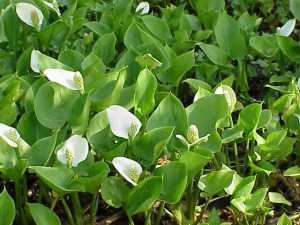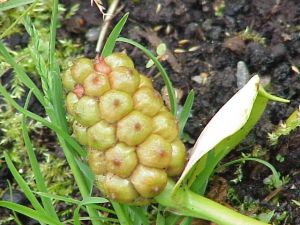Not to be confused with the similar “Caltha palustris”, this water-dwelling plant is surprisingly hardy(zones 2 to 6). These can be grown both in wet soil and in marshy, muddy conditions with still, shallow freshwater. These perennials also frequently vegetatively reproduce by producing offsets through their rhizomes.
Calla palustris (Calla Lily, Water Arum, Water-dragon, Wild Calla)
Deciduous: no
Hardiness Zones: 2-6
Height: 13-26 centimeters (6-12 inches) tall
Diameter: 13-26 centimeter (6-12 inches) spread
Growth Rate: moderate
Age: perennial
Root System: fairly small, serves as an anchor in wet regions
Family: Araceae
Subspecies: none
Tolerates: very wet soil, thrives in boggy/marshy conditions
Problems (major): extremely intolerant of drought
Problems (minor): few minor issues
Poisonous: Every part of this plant contains calcium oxalate crystals. If ingested, these cause inflammation and burning of the lips, tongue, mouth, and throat. The dried berries are edible, but eating them without consulting a licensed physician/medical doctor is not recommended.
Soil Requirements: prefers acidic, humusy, very moist (muddy) soil (can live in land or still water), accepts clay, loamy, and sandy soils
Air Requirements: not sufficiently researched (I have found nothing specificly stated.)
Watering Requirement: grows well in still, shallow water with muddy soil
Sun Requirement: Grows best in part-shade, full shade causes the stems to wilt a bit.
Leaf shape: oblong and heart-shaped
Leaf size: 5-12 centimeters (2-5 inches) long
Flower structure: The inflorescence consists of a medium to dark green peduncle (9-11 centimeters, 4-5 inches, tall), a white spathe, a light green spadix, and yellow and white flowers. Produces small, globular red fruits.
Flowering frequency: flowers June-July
Bulb/tuber: bulb, produces rhizomes
Monocot/Dicot: monocot
Annual/Biennial/Perennial: perennial
Depth: Shallow water, the crown (where the roots and stem meet) won’t be damaged with 4-5 centimeters (2 inches) of water above it.
Freshwater/Saltwater native: freshwater
Location (Pond, Stream, River, Lake, Sea, Ocean): pond
Unicellular/Multicellular: multicellular
Colonization: very minor (Reproduction by rhizomes is the closest equivalent.)
Motility: little to none
Nautical reproductive cycle: can vegetatively reproduce by producing offsets through rhizomes
Alternation of isomorphic/heteromorphic generations: neither
Notable characteristics:
Easily divides, especially in spring and in marshy soils. Grows in both moist soils and in still and shallow freshwater bodies.
Uses:
Occasionally grown in marshy or wet gardens. Almost never eaten. The foliage isn’t outstanding, although the inflorescences look nice.
Sources used:
- http://www.missouribotanicalgarden.org/PlantFinder/PlantFinderDetails.aspx?taxonid=276335&isprofile=1&basic=Water..
- https://gobotany.newenglandwild.org/species/calla/palustris/
- https://www.wildflower.org/plants/result.php?id_plant=CAPA
- http://plants.usda.gov/core/profile?symbol=CAPA
- http://www.pfaf.org/user/Plant.aspx?LatinName=Calla+palustris
- http://practicalplants.org/wiki/Calla_palustris
- http://www.seapets.co.uk/products/pond-supplies/pond-plants/marginal-plants/bog-marginal-plants/all-products.html
 Calla palustris at “Southern Heath Nature Park”, Germany (uploaded 28 August 2013)
Calla palustris at “Southern Heath Nature Park”, Germany (uploaded 28 August 2013)
 2 inflorescences (uploaded 2004 by Kurt Stüber)
2 inflorescences (uploaded 2004 by Kurt Stüber)
 Several leaves and inflorescences (uploaded by Kurt Stüber in 2004)
Several leaves and inflorescences (uploaded by Kurt Stüber in 2004)
 Immature seeds (uploaded 2004 by Kurt Stüber)
Immature seeds (uploaded 2004 by Kurt Stüber)
 Mature red seeds (uploaded 24 August 2012)
Mature red seeds (uploaded 24 August 2012)
I do not own the rights of these images; all credit goes to its original creator(s).
